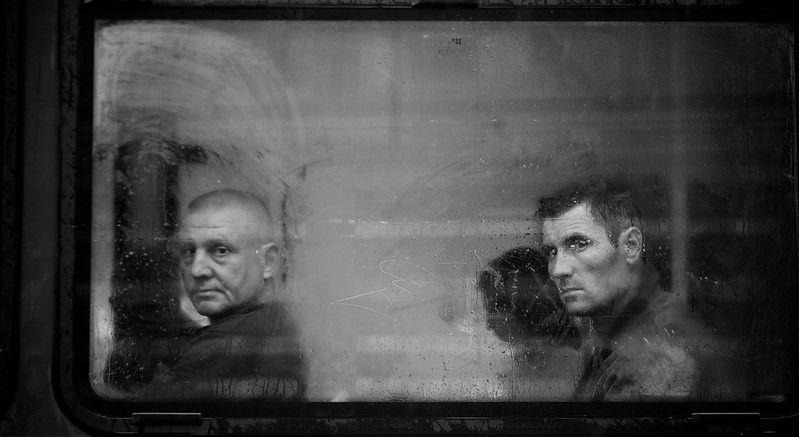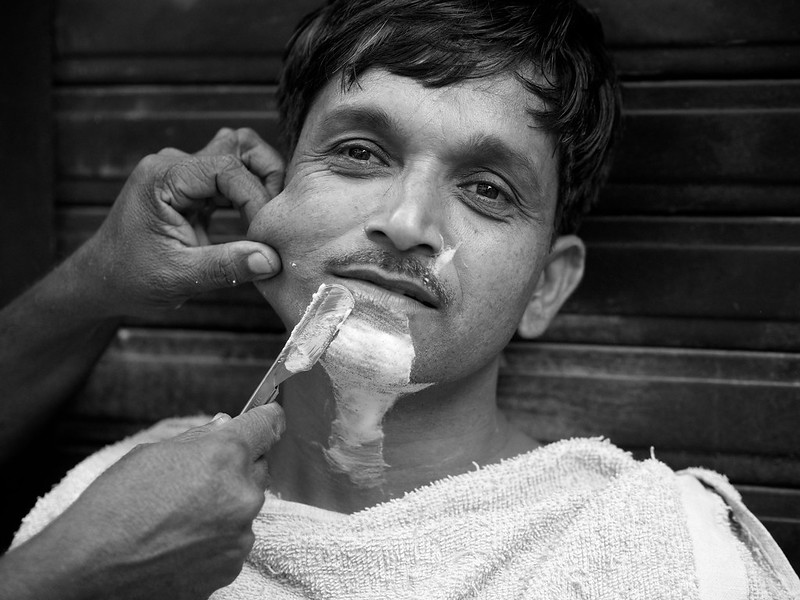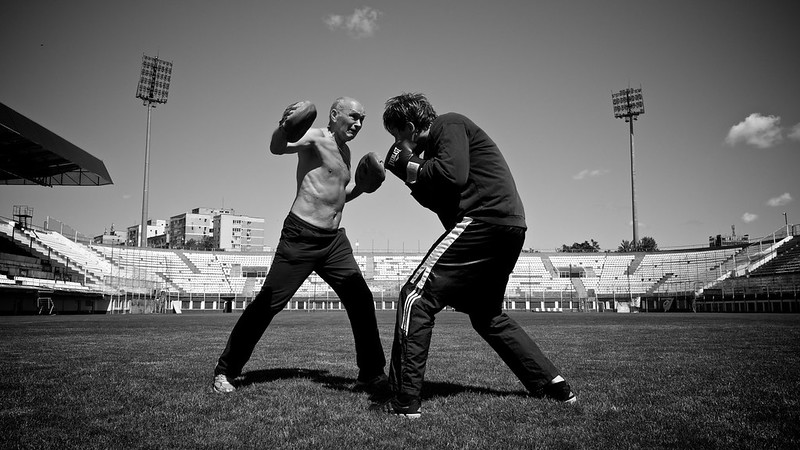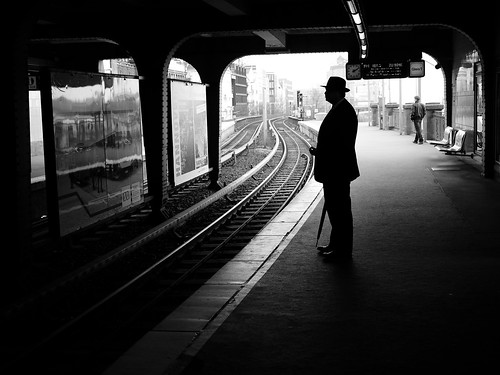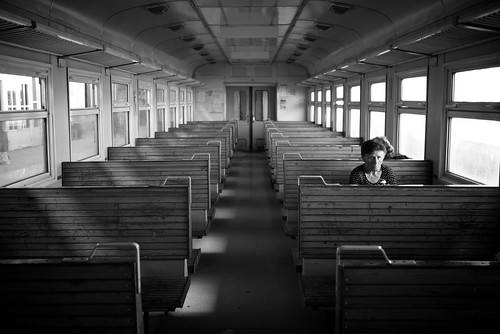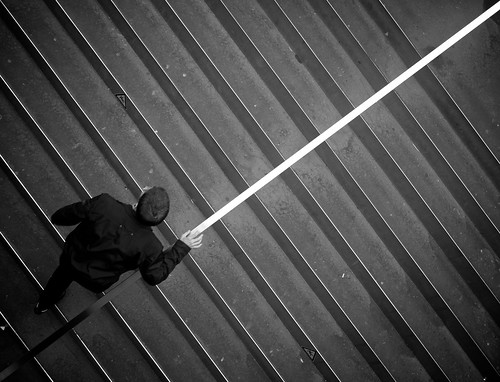“Street Photographer“ Thomas Leuthard from Switzerland
Thomas is a passionate „Street Photographer“ from Switzerland who has gained quite some popularity in the „Street Photography“ community. You can find more of his work here on flickr. He beliefs in giving back to the community and this is why he has published several ebooks, which are available for free on his website. Now, without further ado, lets get things started.
Thomas, we are very happy and we feel honored that you agreed to answer some question for us. Everybody knowing you, immediately associate your work with the genre of “Street Photography”. What does “Street Photography” mean to you? What makes a good “Street Photographer” in your opinion?
Street photography means a lot to me. It was the genre of photography which has shaped me over the last 5 years. It has changed my life by seeing things I would never have seen without my camera. I have been in many different places which I never forget and which have made me wonder why we live like we live in our country. It has shown me that money can’t buy happiness or that materialism will not make a better person out of yourself. I found friends around the world and keep meeting new ones every day. I have found out that we are all the same and when we share the same passion there is no barrier between us. You have always something to speak about when you like street photography. You can have long walks with a complete strangers and feel highly connected at any time. I have never met a not likable street photographer which means that there is more than a passion. It’s something like caring about people which drives us.
A good street photographer doesn’t care about gear. He knows what he holds in his hands and also knows how to handle the tool that extends his eye. He’s looking and exploring much more than he is shooting. His eyes see things others don’t even can imagine. He is more interested in people and their behavior than in the place where he is. He can ignore the hottest woman in the world passing by, when he has another assignment to fulfill. But he can also focus on something which appears to be impossible and it will happen in the next minutes. A good street photographer has a lot of fantasy and every frame appears first on his mind before he tries to bring it to the sensor. He is more introverted and walks often alone as this is the best way of finding the unexpected moments of the ordinary life. He’s working in an invisible and hidden way, by moving slowly and pretending eye contact with the people he is taken photos of. Normally a street photographer is not talking to the people he shoots, as this will not improve the image which he has already taken. Of course a conversation can always broaden your mind, but it also takes a lot of time, which means fewer photos. A good street photographer doesn’t judge a day by the amount of keepers, but by the feeling of received happiness. You can be satisfied with just one good shot which you could have taken within the first minute of a day long walk. It’s all about getting happy.
Well, it seems like photography has become an integral part of your life. Maybe it even transcends from the pure image taking process to a life style. “Street Photography” is so much more than just taking images on the streets. The real value and importance of of this genre is not easy to understand. When explaining “Street Photography” we often hear people talking about documenting the “human condition”. What kind of purpose do you see in “Street Photography”? How would you explain this genre to someone unfamiliar with this kind of photography?
When I’m not motivated anymore, I ask myself the question about the purpose and I may be unable to obtain the right answer. Because I don’t do it for my followers, I don’t do it to become famous (anymore), I don’t do it for the the photos and I don’t do it just for fun. Today I shoot in the streets because it makes me happy when I see an interesting situation or when there is an outstanding character. There were times when I didn’t see anything anymore or when I was thinking about giving up street photography. Those moments are seldom, but they will always come back. But since street photography is more a feeling than an activity to me, I hope it’s always coming back. Although the past has shown that I did often things for several years very intensively and then completely gave it up. We will see…
When someone unfamiliar asks me what I do on my trips, it’s often more straightforward to show this person some photos. Because when my answer is “I take photos of strangers in the street” people don’t really understand what street photography is and it sounds very boring. But as soon as I show some of my photos, people realize that it is a craft and not a hobby. I would even say that photography is secondary. Primary street photography is a kind of social study showing what kind of people there are and what they are doing out there. The camera is basically only present to document everything. Theoretically I could just observe with my eye and don’t capture the scenes. Nevertheless, then nobody else would be able to see what I see. That’s why I capture those moments.
Documenting life on the streets has a long history. Many great photographers spent their whole life shooting the streets. Some of them refuse to be pigeonholed as “Street Photographers”. Maybe this is due to the fact that there is a fine line between documentary photography, photojournalism and fine art “Street Photography”. Where do you see your work?
I don’t like labels and I don’t really care how my way of photography is being called. Some people even say that a candid portrait of a stranger is not street photography. Of course my style is closer to Vivian Maier than the work of Matt Stuart or Siegfried Hansen. That shows that the term street photography is being used for any kind of style. I would tell you that I document life on the street. Sometimes it’s just a snapshot, sometimes it’s a highly composed graphic photograph. For me it’s more important that I can keep a certain personal style, that people recognize my work without seeing my name. And as long as I have fun, people can call my work however they want. Maybe there should be some subcategories in street photography to define all the flavors of this genre. Because it’s so diverse as life itself.
I like the idea of going beyond labels and categories. This helps us to open our minds. Looking at your work, we can definitely see a distinctive style. You present most of your images on flickr and your website in a long flow. Do you work on projects as well or is your work more defined by the single image?
Some of my biggest critics say that I don’t work in a bigger context, which is true. Most of the times I shoot singe images in a certain city. Then I publish photos of one city next to each other which are not in a certain context. But I strongly believe in long term projects which will be in a broader context. For example I often shoot in train stations or other public transport locations. I still believe that there will be an exhibition about public transport in general. The title will be “Grown up at a railway station”, since I spent the first 13 years of my life next to a train station. For me this is a question of focus. Sometimes I follow an idea to document a certain area or city through my eyes or I just use a certain technique to make a series of shots in different cities. In both ways the photos are matching together in a certain way. For me it’s not important what and how you shoot, it’s more important that you shoot. And I have stopped listening to people criticizing my work, especially when they cannot do any better.
As soon as we start following our heart and do things we truly believe in, we are often confronted with critics. Overcoming the fear of doing something others don´t like, is definitely important and something that shapes our photographic identity. You have mentioned before that you shoot candid street portraits. We see a lot of very intriguing portraits in your stream. How important are those portraits for you? Do you set up those situations or do you prefer the candid moment?
When I started street photography, I thought the closer you get the more brave you are. I did a lot of those close candid portraits. After some years I realized, that such portraits don’t really tell a story, because they are too close. You don’t see where the person is, what he is doing or even wearing. For me it’s important that my photos are all candid. It’s very seldom that I ask someone upfront. I think you can see it in the eyes, if you asked or not. The look of a candid portrait is much more intense, which like much more. Today I don’t take a lot of portraits anymore, as I got bored. But if I see an interesting character, I still cannot resist getting close, pressing the button.
Street Photography is not an easy genre. Photographers always have to deal with legal requirements and people seem to avoid being photographed or have their pictures published. How do you deal with those restrictions?
Normally my answer is very short: “I take the risk.” But I know that a lot of people cannot really take this answer for real. First of all I know that the chance is pretty small, that some will see his photo on Flickr, Facebook, Google+ or anywhere else on the Internet. Then what can a person do, when he sees his photo? He will write you a message that you have to take it down. He could also take you into court and try to get some money for his “damage”. But what kind of damage did happen to him? Probably not a big one. Another problem is that there are no similar cases out there. As long as you don’t sell the photos nor earn money with them, it’s not that critical. But you still have to take a certain risk as it is not allowed in most of the countries to publish a photo without acceptance of the person recognizable. Another issue is the effort you would have to take to make street photography the proper way. You would need a signed model release contract for every person recognizable in ever photo you upload. And you have to keep those contracts together with the photos. This would be a big pile of paperwork.
We can also observe a fine line between voyeurism and the desire to document a fleeting moment. So we need to talk a bit about ethos. A German photographer recently uploaded a black image during a series about refugees, because I did feel publishing the image was inappropriate. Where are your personal limits, the borders you don’t want to cross when it comes to privacy and respect?
This question you cannot answer in a general way. I have learned with some photos that people react much more sensitive than I thought. Although I show the reality they are not willing to see it. Apart from that there are too many people who a living in a perfect world and think that what I show is not the reality. I have seen many things while traveling and still believe that I have to show most of it. Regarding ethics it’s important for me to take the photo with a certain respect, if this is possible. Being a street photography is not an easy job sometimes and I don’t want to show the bright side of life. There are too many bad things happening on this planet and too many people ignoring this fact. Therefore I will keep showing different images and there will be some disturbing ones. For those who don’t seek the truth, they should choose another genre of photography to follow.
You share a lot of your knowledge on your blog and via free ebooks. This is great! Of course everybody loves free things, but what is your motivation for giving so much back to the community?
This question has been asked many times. It is mainly being raised by people from the western world, where people are driven by money. I’m lucky that I was born in one of the richest countries of this world and that I have a well paid job in IT. Therefore I don’t have to earn money with my photography. For me it was important that the ebooks were written in a language, most of the people understand and that they are available for everyone on this planet. So I write them in English and made them available as a free PDF. I guess this was a major part of the success of my ebooks. As John Ruskin once said: “The best work never was and never will be done for money.”
In one of your last blog posts you mention that you are working on an ebook about minimalism in “Street Photography” and why gear and other stuff is not important. This sounds like you don´t think a fancy Leica is the only camera good for “Street Photography”. What is your equipment and how important is it to have the right tool?
I don’t Leica and I don’t appreciate the question about my camera or what lens I was using. It’s not important! I have seen street photographers with Leicas who were not in a position to impress me in any way. I have likewise seen people who shot photos with an iPhone which blew me away. Who would care on which device the Harry Potter books were written? Nobody. So why does everyone care with which camera a photo was taken. It’s a black box with a whole. Nothing more, nothing less. And if you really believe that a red dotted camera would change anything, you have not understood the concept of street photography. It’s not important which tool you use, it’s more important that you know your tool and that you can operate it in the dark within a fraction of a second. My new ebook will be called “Minimalism in Street Photography” and will start with the quote “You can have the best camera in the world, but if your eye can’t see, it won’t make a difference.” And if you really want to know, which camera I’m currently using, it’s an Olympus OM-D E-M10 with a 17mm f/1.8 lens.
I am sure this will be a very interesting ebook that will even help people to go out and shoot using whatever equipment they have available. Thomas, I probably know your answer to the following question already from what you have said before, but I still want to ask it. How important is truth in your work? Image manipulation has its history long before photoshop. However cloning and stamping is much easier today than it was a couple of years ago. Does changing content in a photograph has its place in “Street Photography”? Do we loose the whole spirit by manipulating what the camera captured?
The truth is not only important in street photography, but also in life. Why should I manipulate a photograph I have taken on the street to document life? I cannot change the content of a photograph with post processing. I have enough possibilities to get the right content into the frame by position my camera correctly. So why would people think that post processing would be a game changer? Probably the same people who think a like would change anything. Post processing is not very important in street photography. I would publish out of the camera shots, if my Olympus OM-D would have a stronger black & white. I remember one of my best shots which I took with a Panasonic GF1 was a JPG out of the camera.
Thomas, as we are coming to the end of the interview, I am interested to hear what plans you have for 2015 regarding photography? You have mentioned that you travel a lot and enjoy the friendship with fellow “Street Photographers” all over the world. What are your travel plans for 2015?
I didn’t do any new year resolutions for 2015, but I want to finish this minimalism ebook in the next days. There is a plan for another video training about composition. There might be another ebook with 50 assignments for the streets, but this might take some more time. My next destinations are Belgrade, Prague, Delhi, Hamburg, Berlin, Iceland, Chicago, Munich and Muscat. There might be a few more places as you never know.
What kind of advise would you give to a new and aspiring „Street Photographer“?
- Don’t buy books. There are enough free resources out there.
- Don’t talk to gear heads.
- Use the camera you have.
- Practice as much as you can. Make a lot of photos.
- Make little projects in order to focus.
- Get closer, no matter how close you are already.
- Choose a different point of view for a more interesting composition.
- Don’t listen to others. You only shoot for yourself.
- Don’t imitate, innovate. Find your own style.
- Stay Curious. Stay Creative.
I think this nicely wraps up our little conversation. Thank you very much for taking the time. I enjoyed this interview a lot!


